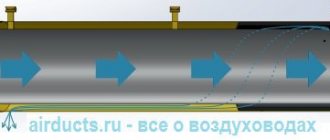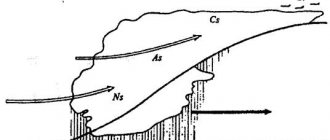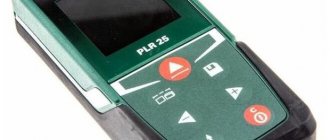4.9
Average rating: 4.9
Total ratings received: 19.
4.9
Average rating: 4.9
Total ratings received: 19.
In the 6th grade geography course, schoolchildren become familiar with the weather and its main characteristics. The most basic elements of weather that affect people and economic activities are temperature, precipitation and wind. Wind is the horizontal movement of air masses. It affects not only the activities of the population, but also the formation of aeolian landforms and the distribution of plant seeds.
What is a wind net called?
A windsock cone (colloquially a sorcerer or a sausage) is a fabric cone designed to indicate the direction and approximate speed of the wind. ... To ensure control over the speed and direction of the wind in the dark, a backlit windsock can be used.
Interesting materials:
What is the NFS module in smartphones? Is it possible to not fully charge a smartphone? Is it possible to wear a fitness bracelet without a smartphone? Can I print from a smartphone? Is it possible to charge a smartphone up to 100%? The battery on my smartphone runs out quickly, what should I do? My smartphone is heating up, what should I do? My smartphone is not charging, what should I do? What is NFC in a smartphone? Nfs what is it in a smartphone?
Which taps should be equipped with an anemometer?
To prevent the crane from being hijacked by the wind and to alert the crane operator with an audible signal about wind speeds dangerous for work, anemometers must be installed on tower, portal, cable mobile cranes and bridge loaders, which automatically turn on the existing or installed additional siren on the crane.
Interesting materials:
Who is on the jury to vote for the children of 2022? Who is part of the triumvirate created in 60 BC? Who headed the French provisional government in 1871? Who won Person of the Year 2022? Who won the 2022 championship? Who won X Factor Kazakhstan 2022? Who won first place at Junior Eurovision 2022? Where can you go on vacation in 2022? Where can you go in 2022? Where to go in 2022?
Instruments for measuring wind speed and direction.
Instruments that measure wind speed are called anemometers; measuring speed and direction - anemorummeters; recording speed and direction - recorders.
Figure 7.1 – Basic directions
The station weather vane (Wilda weather vane) is simple in design and is quite widely used to measure the direction, speed and gusts of the wind (Fig. 7.2).
The sensitive element of the wind direction in this device is a wind vane 1 with a counterweight 2. It is mounted on a tube 7, which is put on the pointed end of a fixed axis 3 and rotates freely around it. To determine the direction of the wind, a coupling 4 with eight pins indicating the direction of the cardinal points is located on the fixed axis. On one of them the letter C is fixed, directed to the north. The wind speed receiver is a rectangular board (plate) 5, swinging freely about a horizontal axis 6. An arc 8 with eight pins is fixed to the axis, along which the position of the board, deflected by the wind, is measured. On the axis 6 there is a counterweight 10 to balance the arc 8. The pins of the arc are numbered from 0 to 7.
Figure 7.2 – Wild weather vane (according to M.D. Pavlova, 1974)
Manual cup anemometer MS-13 (Fig. 7.3). Its sensitive element is a small pinwheel 2 with four hemispherical cups with their convexities facing one direction. The turntable is mounted on axis 1, in the lower part of which there is a worm (screw) thread, which is in contact with a gear wheel that transmits the rotation of the turntable to the counting mechanism. The counting mechanism is placed inside the housing and is a system of gear wheels connected to three arrows, which, when the turntable rotates, move along three scales.
scale 6 has 100 divisions. This scale is used to count tens and units of revolutions. Small scales have 10 divisions and are used to count hundreds and thousands of revolutions.
The counting mechanism is turned on and off by a arrester, the protruding end of which is located on the side of the housing and has the appearance of a movable ring. By moving the lock up (counterclockwise), the anemometer counter is turned on, and by moving it down (clockwise), it is turned off. Two ears are screwed into the body of the device on both sides of the arrester, through which the ends of the cord are pulled, attached to the ring to turn the device on and off when it cannot be reached by hand. Below, under the device body, there is a rod with a screw thread 4 for installing the anemometer on a wooden pole in a vertical position.
Figure 7.3 – Manual cup anemometer MS-13 (according to A.P. Losev, 1994)
The turntable is protected from mechanical damage by metal arms 7. The anemometer is stored in a case with the mechanism turned off.
Anemorumbometer M-63 is a remote device (Fig. 7.4).
It measures wind speed averaged over a 10-minute interval, the maximum instantaneous wind speed between observation periods and wind direction. Figure 7.4 – Anemorummeter M-63 (according to M.D. Pavlova, 1974)
The operating principle is based on converting wind direction and speed into electrical quantities. The device kit includes sensor 1, measuring panel 2 and power supply 3 .
The sensor consists of a streamlined body rotating around a vertical fixed post. At the end of the body there is a wind vane 5, and at the beginning there is a four-blade propeller 4 with a horizontal plane of rotation, which, with the help of a wind vane, is always installed perpendicular to the direction of the air flow. At the bottom of the vertical stand there is a guide for installing the sensor relative to the cardinal points and a plug connector for connecting the connecting cable.
Measuring console - a table-top device, on the front side of which there is an instantaneous speed indicator 6,
average speed indicator 7 and wind direction indicator 8
.
The power supply consists of two rechargeable batteries, a voltmeter for measuring battery voltage and a toggle switch. The power supply is connected to the AC mains.
To characterize the wind regime of an area based on the frequency of wind directions, a graph called a “wind rose” is constructed. It can be monthly, seasonal, annual.
The frequency of wind for each of the eight points is calculated by the number of times that was observed during a particular period. The obtained values are expressed as a percentage of the total number of observations (the number of calms is not included in 100%).
When constructing a wind rose, eight points of wind directions are drawn and the repeatability of the wind is plotted on them on a certain scale. Consistently connected points will characterize the wind rose.
Approximate compass rose
1. Construct wind roses in the direction of the wind in May and June
| Month | WITH | NE | IN | SE | YU | SW | Z | NW | Calm |
| May | |||||||||
| June |
1. Wind and its characteristics.
2. The importance of wind for agricultural production.
3. Instruments that characterize wind.
4. Hand-held anemometer and the principle of its operation.
5. Wind rose and its construction.
This page was last modified: 2016-12-17; Page copyright infringement
Variety of models
Depending on the principle of operation, the device for measuring wind speed is manufactured in three versions:
- Mechanical. Due to the movement of air in them, individual elements rotate. This category includes cup and vane (or blade) anemometers. They differ from each other in the design of the element that perceives air flows.
- Heating (or thermal). Their design includes a heating element (usually a simple incandescent wire). Under the influence of moving air masses, this element cools down. The device determines the degree of temperature reduction.
- Ultrasonic, which measures the speed of sound. Sound passing through moving gas has different speeds. If it moves towards the wind, its speed will be lower. Conversely, when moving in the same direction as the wind, its speed will be higher than in still air.
Device for measuring wind speed (anemometer): types, instructions. Vane anemometer
Meteorological devices include a device for measuring wind speed called an anemometer. Translated from ancient Greek, the definition literally means “wind gauge.” Despite the name, the device was invented only in the 19th century. It was invented by Irish astronomer John Robinson to determine wind speed.
What is the device used for?
Today, the anemometer device can be found in various industries:
- At meteorological stations that operate to observe the weather.
- At airports. They are used by the flight safety service.
- To determine draft in ventilation systems in the mining and coal mining industries.
- In construction, anemometers are used to ensure safety: the device is mounted on the top of the crane boom. When the wind speed reaches above the specified parameter, work is prohibited.
- In agriculture, this device is used when treating crops with chemical protection agents and fertilizers.
A device for measuring wind speed. Meteorological instrument
A device for measuring wind speed and determining the direction of its blowing is known as an observatory, or anemometer. Such devices are used when it is necessary to control the parameters of the movement of air masses.
Operating principle
Instruments in this category are capable of determining the maximum current wind speed when the flow is blowing in a certain direction. Some models provide indicators of volumetric air flow, flow temperature, and humidity. Thus, a functional instrument for measuring wind speed turns into a portable weather station.
There are several separate types of devices capable of calculating wind speed. Currently, the following types of devices for this purpose are distinguished:
- rotational;
- vortex;
- thermal;
- dynamometer;
- optical;
- ultrasonic.
Let's take a closer look at devices of each type, determine their capabilities and methods of operation.
Rotational anemometers
Designs of this type were invented quite a long time ago. However, despite the advent of more advanced instruments, rotary anemometers still continue to be successfully used by meteorologists around the world.
Vortex anemometers
Currently, hand-held vortex anemometers are the most common. The latter are used to measure the speed of air flows in ventilation systems and pipelines, and are installed in air ducts of industrial and residential facilities.
Thermal anemometers
Thermal appliances are not in great demand. Most often, the need for their use arises when measuring slow air flows.
The thermal wind speed sensor operates on the principle of measuring the temperature of an incandescent filament or a special plate on which air pressure is applied. At different flow rates, a certain amount of energy is released, which makes it possible to maintain a particular temperature of the thermal element. In this simple way the wind speed is determined.
Dynamometer anemometers
A dynamometer for measuring wind speed is used not only in meteorology. Similar devices are installed in ventilation systems and gas ducts, where the volumetric flow rate and their speed are calculated.
Ultrasonic anemometers
The operating principle of devices in this category is based on determining the speed of sound at the receiver depending on the air mass flow indicators. The most high-precision, modern devices are presented here, which also allow you to record the direction of wind flows.
There are three-dimensional and two-dimensional ultrasound devices. The first make it possible to obtain indicators of the direction of movement of flows in three components. In turn, a two-dimensional meteorological instrument allows one to measure wind direction and speed only in the horizontal plane. Some ultrasonic systems calculate the temperature of air flows.
Optical anemometers
The scope of application of optical anemometers is extremely wide, starting from determining the directions of movement of substances in living cells and capillaries and ending with calculating the speed of movement of gases in the atmosphere.
The operation of laser devices helps to accurately calculate the speed of air flows around moving objects, in particular, vehicles, aircraft, and space bodies. The resulting calculations enable researchers, engineers and mechanics to develop the most aerodynamic shapes when designing equipment.
Tips for choosing
- maximum measuring range;
- magnitude of errors;
- possibility of use in certain temperature conditions;
- level of safety for the user when the device is exposed to aggressive environmental factors;
- type: stationary or portable device;
- degree of protection of the mechanism from the effects of precipitation;
- the nature of the device’s power supply and the method of data generation;
- dimensions of the device;
- the ability to calculate indicators at night (presence of backlight).
Currently, to work in conditions of extremely low temperatures, it is possible to use meteorological instruments with heaters. Specialized anemometers are used for mines and mines, which are able to function properly in highly dusty environments and in explosive environments. Such functional devices can withstand exposure to high humidity and remain operational under significant temperature changes.
Eventually
As you can see, depending on personal needs, it is possible to choose the most suitable device for recording air flow indicators. However, there are difficulties here. Since all anemometers are measuring instruments, they are subject to certification and certification in the relevant government agencies.
Thermal appliances
The operating principle of such anemometers is to determine the electrical resistance of the wire. This value changes depending on the temperature, which is reduced by the moving air flow. It is similar to how on a hot sunny day the breeze cools your skin.
The design of the anemometer is a metal filament (made of platinum, nichrome, silver, tungsten and other metals), which is heated by electric current to a temperature exceeding the ambient temperature.











